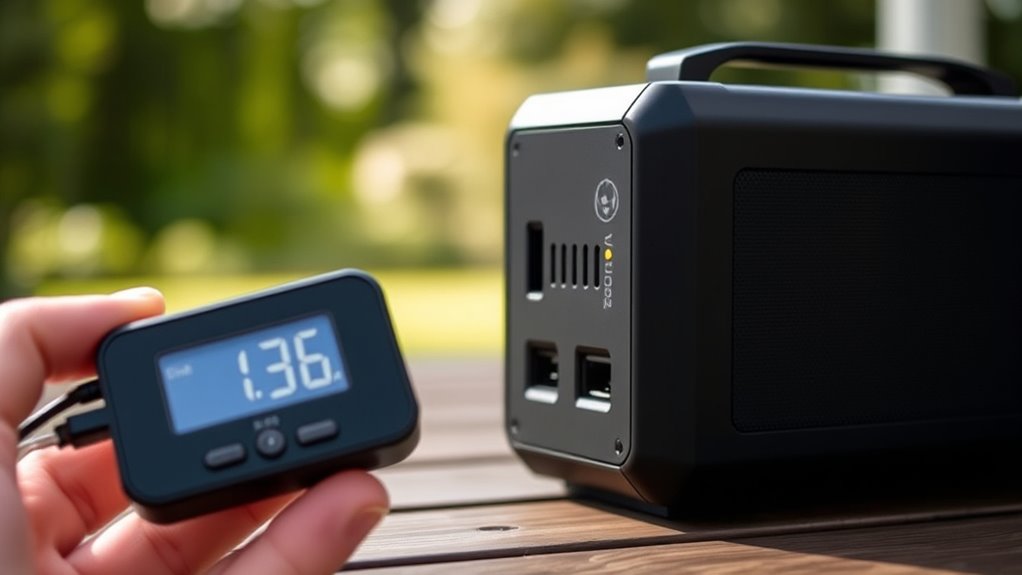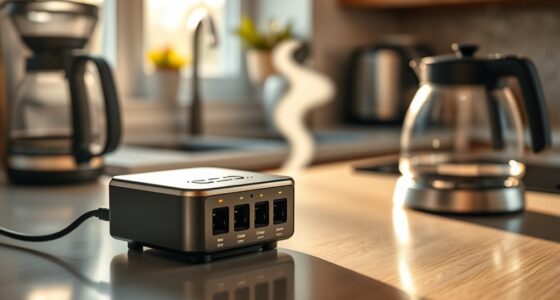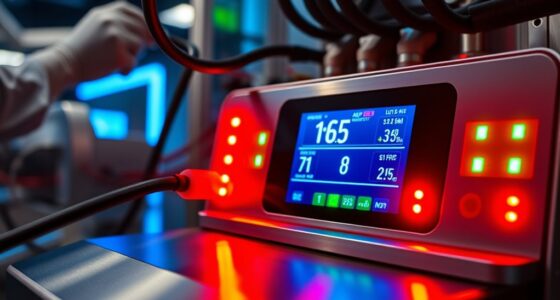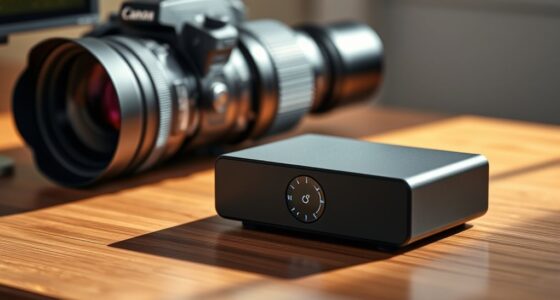Measuring noise levels in portable power stations is essential to guarantee your safety, stay compliant with regulations, and keep equipment running smoothly. Use sound level meters or noise dosimeters to get accurate readings, and regularly check for abnormal sounds that could signal mechanical issues or battery problems. Maintaining proper noise levels helps you prevent costly repairs and extend device life. Keep going, and you’ll discover even more about how monitoring noise can benefit your operations.
Key Takeaways
- Use sound level meters or noise dosimeters to accurately measure noise emissions from portable power stations.
- Regularly monitor noise levels to ensure compliance with safety regulations and protect worker hearing health.
- Abnormal noise readings can indicate equipment issues, overheating, or mechanical stress requiring prompt troubleshooting.
- Measuring noise helps assess the efficiency and performance of power station components, preventing potential failures.
- Documenting noise levels supports safety standards, guides control measures, and promotes a safer working environment.
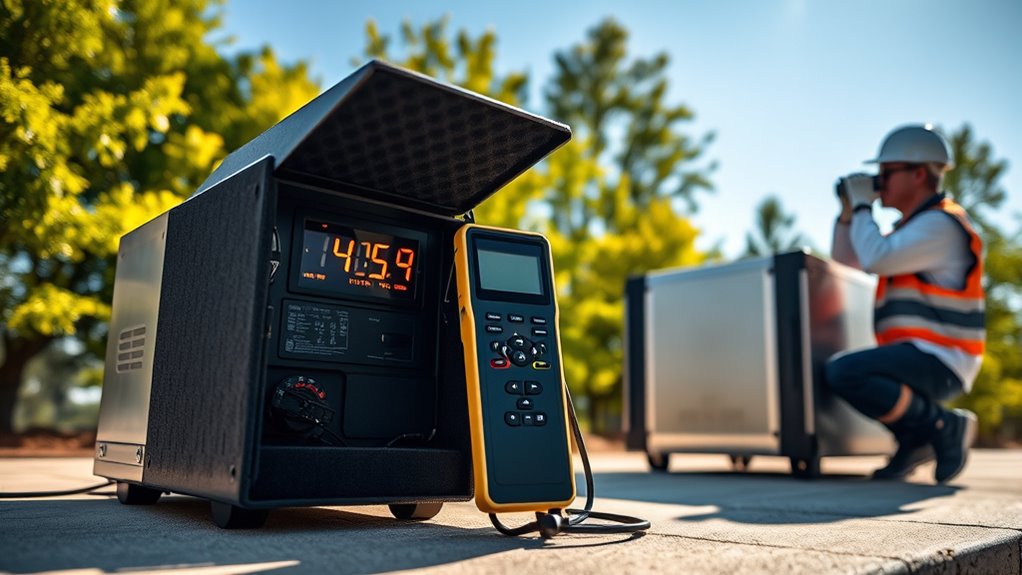
Measuring noise levels in power stations is vital to guarantee safety, comply with regulations, and protect workers’ hearing health. When operating portable power stations, understanding the noise output helps you identify potential hazards and enforce safety standards effectively. High noise levels not only risk hearing damage but can also indicate underlying issues affecting equipment performance, such as battery efficiency. If a power station’s noise exceeds recommended limits, it may signal that components are under strain, reducing battery efficiency and risking system failure. By monitoring sound levels regularly, you assure that your operations stay within acceptable safety standards, minimizing health risks for everyone on-site.
Accurate noise measurement also plays an indispensable role in adhering to safety standards set by regulatory agencies. These standards specify maximum permissible noise levels to protect workers from long-term hearing damage. Using sound level meters or noise dosimeters, you can precisely gauge the environment’s noise output at different operational stages. This data allows you to implement control measures, like installing sound barriers or scheduling maintenance during quieter periods, ensuring compliance with legal requirements. Maintaining compliance not only safeguards your workforce but also helps avoid penalties and legal liabilities associated with violations.
Furthermore, understanding the relationship between noise levels and battery efficiency is vital. Excessive noise often correlates with mechanical strain or overheating, which can diminish a portable power station’s performance over time. When components vibrate or generate abnormal sounds, it might indicate that the batteries or internal parts are under stress, leading to decreased capacity and shorter lifespan. By regularly measuring noise levels, you can detect early signs of inefficiency or malfunction, allowing prompt intervention before serious damage occurs. This proactive approach helps extend the lifespan of your equipment, ensuring reliable power supply when you need it most.
In addition, integrating noise measurements into your maintenance routine can streamline troubleshooting. If a portable power station suddenly becomes noisier, you’ll have concrete data to diagnose issues quickly. This can prevent costly repairs and downtime while maintaining safety standards. It’s also a way to educate your team on the importance of monitoring environmental conditions, emphasizing how noise control aligns with safety protocols and operational efficiency. Ultimately, routine noise assessments empower you to optimize performance, uphold safety standards, and ensure your portable power stations operate at peak battery efficiency, all while protecting your team from preventable health risks.
Implementing regular noise monitoring can also help you identify equipment inefficiencies early, enabling proactive repairs that save costs and extend service life.
Frequently Asked Questions
How Does Noise Affect Portable Power Station Performance?
Noise can impact your portable power station’s performance by causing distractions and potential overheating. Excessive noise pollution may indicate that the device is working harder, which could reduce efficiency or lead to damage over time. Sound dampening features help minimize noise levels, allowing smoother operation. By managing noise pollution effectively, you guarantee your power station runs quietly, stays cool, and maintains ideal performance for longer periods.
Are Quieter Models More Expensive?
Imagine whispering winds rather than roaring storms—that’s what quieter portable power stations bring to your outdoor adventures. Usually, these models cost more, reflecting advanced technology and meticulous design. A thorough cost comparison shows that premium brands with stellar reputation often charge a premium for quieter operation. While the initial investment might seem steep, the serenity and convenience they provide can make your trips more enjoyable and stress-free.
What Is Considered Acceptable Noise Levels for Outdoor Use?
For outdoor use, acceptable noise levels typically stay below 60 decibels to minimize noise pollution and avoid disturbing neighbors. You should look for power stations with good sound insulation to keep noise levels manageable. Lower noise levels help you enjoy your outdoor activities without causing a disturbance. Keep in mind that quieter models are often more expensive, but they’re worth it for peaceful outdoor environments.
Can Noise Levels Vary With Different Battery Capacities?
You might notice that noise levels can vary with different battery capacities. Larger batteries, or bigger battery sizes, often require more power and can generate more noise due to increased activity or cooling needs. This noise variation happens because the power station’s components work harder to support larger batteries, making the device louder. So, if you’re choosing a portable power station, consider how battery size could impact its noise level during use.
How Often Should Noise Levels Be Tested During Operation?
You should regularly perform noise measurement testing to guarantee your portable power station operates quietly. The testing frequency depends on usage intensity and environment, but a good rule is to check at least once a month during normal operation. If you notice increased noise levels, conduct additional testing to identify issues early. Consistent testing helps maintain peak performance and prevents unexpected noise-related problems.
Conclusion
As you stand nearby, the quiet hum of the power station suddenly shifts. You notice the subtle rise in noise levels, hinting at what’s hidden beneath the surface. Will it stay silent, or escalate into a roar? Measuring noise isn’t just about numbers; it’s about prediction and control. Keep your eyes on those readings, because one unexpected spike could reveal more than you think—changing how you trust your portable power station forever.
